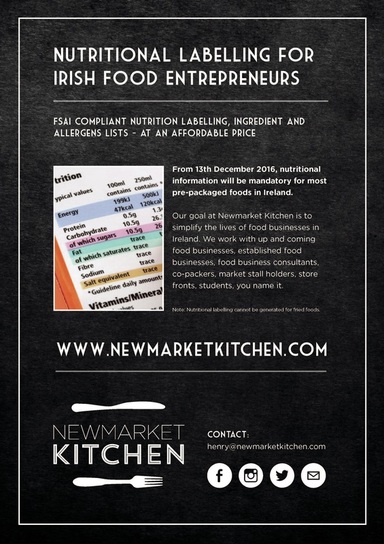Nutritional Content Labelling
Step 1
Newmarket Kitchen
Step 2
Step 3
You’re products are correctly labelled to industry wide standards
New Labelling Legislation from December 2016
Frequently Asked Questions on
Nutritional Content Labelling
All information regarding the following must be declared per 100g/ml of the final product: Energy (kJ/kcal), Fat (g), Saturates, Carbohydrates (g), Sugars (g), Protein (g) and Salt (g).
The nutritional information must be presented in a tabular format with the numbers aligned. If the space on the packaging is limited, the declaration may appear in linear format. If you are considering using a linear format, voluntary information, such as marketing information must not override the nutritional information. All information must be clearly spaced and presented in a clear format.
Our food scientist can analyse your product for its nutritional labelling using a tailored software in place of lab testing. All we need is your ingredients per 100g. Contact us today for more information; [email protected]
- It can be considered more accurate in the long term as it takes nutritional variation of the ingredients in the product into account- unlike lab tasting which tests only that specific sample.
- Receive more usable information
- Fraction of the cost
- Don’t have to send away a sample of your product.
- Nutritional table with Group 2 (legal requirement) information for the back of the package, with nutrients per 100g (per portion and %RI per 100g + per portion if you wish)
- A front of package nutritional label (optional in its use by law)
- A detailed analysis of 300 nutrient factors for the product including vitamins, minerals, lipid components etc. Allowing you to make nutritional claims on your package such as high in vitamin C, low sodium
No, it is a legal requirement for the amounts given per 100g/ml. However, other information can be provided voluntarily:
- Information can be given per portion provided the size and number of portions. All extra information must be indicated near the nutrition declaration – ideally to the right of the initial information
- Often, the percentage Reference Intake (RI) value provided by the nutrients per 100g/ml of the product or per portion, can also be given. RI values are listed in Annex XIII of the legislation.
If %RIs are given then the following statement must also be displayed in close proximity – ‘Reference intake of an average adult (8,400kJ/2,000kcal)’.
Yes, you may also include one or more of the following: Monounsaturates, Polyunsaturates, Polyols, Starch and Fibre. However, if you’ve made a claim about one of these nutrients then you must include it in the declaration.
Information can also be given on vitamins or minerals, as listed in Annex XIII of the legislation, provided they are present in significant amounts as set out in this Annex. The %RI for vitamins and minerals must be given in addition to the amount.
Nutrients other than those listed above must not in the nutrition declaration as it is considered a closed list. If a claim is made about a nutrient other than these e.g. Omega-3, then the amount of that nutrient can be displayed near the table but not IN the table.
Yes, check out the FSAI page which has a list of these food and beverages.
For more information on the regulation and more FAQ’s, check out the FSAI page; https://www.fsai.ie/legislation/food_legislation/food_information_fic/nutrition_labelling.html
